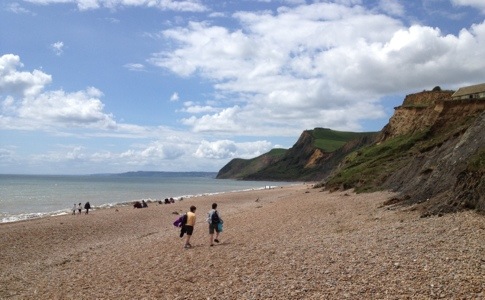More landslips, and consequently diversions, made for a vexatious start today. Having walked inland on the roads from Lyme Regis we finally regained the beach at Charmouth only to be signposted straight back inland. The brief glimpse of Charmouth’s sea front car park hardly justified the effort of walking out to the coast and back again and I’d have been just as happy to forgo that pleasure and link the two diversions together by staying on The Street instead. I’ll know for next time.
But once we had climbed over Stonebarrow Hill and back to the cliffs I forgot my frustrations in my enjoyment of the views along the coast, spectacular despite the cloudy day. The most prominent feature was Golden Cap, the highest cliff on the south coast of Britain, although – ominously – we also had a clear view of the Isle of Portland in the distance, apparently a sure sign of rain tomorrow.
After ten years in Calgary, a stone’s throw from the snow-capped peaks of the Canadian Rockies, Rob was unimpressed with a cliff just 191m high. But when faced with climbing over half a dozen of them in the day I think that small cliffs have their advantages. And, in addition to its height and distinctive two-tone appearance (with a base of dark grey mudrock topped by a triangle of Upper Greensand, a sandstone that turns golden as it weathers) Golden Cap had one other unique feature. In years of walking all around the UK I don’t think I’ve ever seen a double his ‘n’ hers stile before!
By the time we arrived in Eype’s Mouth the sun had finally broke through, providing a great view back to the cliffs we’d just walked over.
It was so exciting to see the sun for a change I decided to stop in West Bay for a celebratory cream tea. Taking the recommendation of the very helpful couple supervising the Eype’s Mouth car park we headed to Haddon House Hotel, which they told us served one of the best cream teas they’d ever had. It came on a ceremonial tray, doily-topped plates nestled on a bed of deep red napkins: undoubtedly the best-presented of the trip. But, while tasty, it wasn’t quite a prize-winner – the side plate of chocolate biscuits added variety but I would have traded it for a second of the lovely but rather small scones, and a larger pot of tea.
From West Bay there was just one more cliff to climb before our campsite at Burton Freshwater. Where my scone had been a little small, the camping pitch I’d booked turned out to be enormous. Promised “a small walkers pitch just big enough for a two man tent” the spot we were allocated would easily fit ten tents the size of mine. It makes me wonder just what equipment the other backpackers in this area are using…







